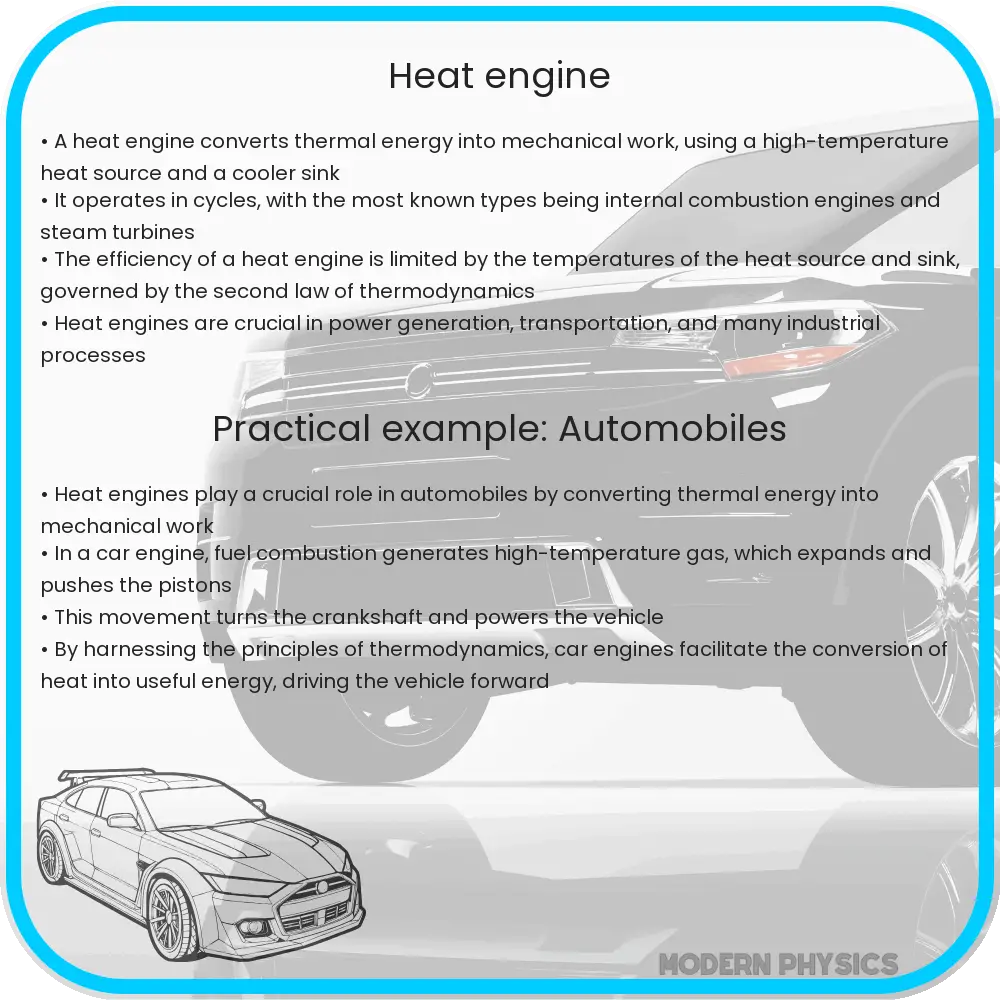Explore the efficiency, dynamics, and power output of heat engines, their environmental impact, and the latest advancements in this in-depth article.

Understanding Heat Engines: Efficiency, Dynamics & Power Output
Heat engines are fundamental to modern technology, converting thermal energy into mechanical work. This process is essential in numerous applications, ranging from automobile engines to industrial power plants. The efficiency, dynamics, and power output of these engines are crucial factors that determine their performance and environmental impact.
The Basics of Heat Engine Operation
At its core, a heat engine operates on the principle of converting heat, often generated from fuel combustion, into work. This conversion involves a working substance, typically a gas or liquid, undergoing a series of thermodynamic processes. These processes can be visualized on a P-V (Pressure-Volume) diagram, illustrating how changes in pressure and volume lead to work done by the system.
Efficiency of Heat Engines
The efficiency of a heat engine is a measure of how effectively it converts heat into work. This is expressed as a ratio of the work output to the heat input. The theoretical limit of this efficiency is dictated by the Carnot efficiency, given by the formula:
\[ \text{Carnot Efficiency} = 1 – \frac{T_{\text{cold}}}{T_{\text{hot}}} \]
where \( T_{\text{hot}} \) and \( T_{\text{cold}} \) are the temperatures of the hot and cold reservoirs, respectively. In real-world applications, factors like friction and heat losses ensure that actual efficiencies are always lower than the Carnot efficiency.
Dynamics of Heat Engines
The dynamics of heat engines involve the study of how energy is transformed and transferred within the system. This includes examining the thermodynamic cycles, such as the Otto cycle for gasoline engines or the Rankine cycle for steam turbines. These cycles describe the sequence of processes that the working substance undergoes, including compression, heat addition, expansion, and heat rejection.
Understanding these cycles helps in optimizing engine design for maximum power output and efficiency. The choice of working fluid, the type of heat source, and the design of the engine components all play a role in the engine’s dynamics and overall performance.
Power Output of Heat Engines
The power output of a heat engine is the rate at which it performs work. It is a crucial factor for applications that require sustained energy delivery, such as in power generation. The power output is influenced by the engine’s efficiency, the amount of heat input, and the operating conditions of the engine.
Engineers strive to maximize power output while minimizing fuel consumption and emissions. Advances in materials science and thermodynamics have led to more efficient engines with higher power outputs, catering to the growing demand for energy-efficient and environmentally friendly solutions.
Advancements in Heat Engine Technology
Recent technological advancements have significantly improved the performance of heat engines. Innovations in materials science have led to the development of more heat-resistant and durable components, allowing engines to operate at higher temperatures and pressures, thus enhancing efficiency. Moreover, advancements in computational modeling have enabled more precise design and optimization of engine components and thermodynamic cycles.
Environmental Considerations
Environmental impact is a crucial aspect of heat engine operation. The combustion process in traditional heat engines emits greenhouse gases and pollutants. Therefore, there’s an increasing focus on developing engines that are not only efficient but also environmentally friendly. This includes enhancing combustion processes, integrating emission control technologies, and exploring alternative fuels like biofuels and hydrogen.
Future Trends in Heat Engine Development
Looking forward, the development of heat engines is likely to focus on sustainability and renewable energy integration. The integration of heat engines with renewable energy sources, such as solar thermal systems, is an area of growing interest. Additionally, the exploration of new thermodynamic cycles and the use of alternative working fluids, which have lower environmental impact, are promising areas for future research.
Conclusion
Heat engines play a pivotal role in modern society, powering everything from vehicles to power plants. Their efficiency, dynamics, and power output are critical in determining their performance and environmental impact. While traditional designs have focused on maximizing efficiency and power output, the modern era demands a balance between performance and environmental sustainability. Technological advancements have led to more efficient, durable, and eco-friendly engines. Looking ahead, the trend is towards integrating renewable energy sources and developing sustainable technologies to meet the growing energy demands while reducing the environmental footprint. The continuous evolution of heat engine technology remains vital in addressing the energy challenges of the 21st century.
